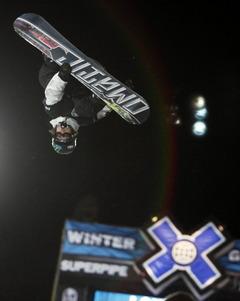 Phải chăng, “đối với người trong cuộc”, hiểm nguy là một thành tố của Thế Vận Hội Mùa Dông: từ người thi thố, thân thuộc, tới giới tổ chức, thành phần khán giả đều chấp nhận, cổ võ, ưa thích, ham mê trạng thái hiểm nguy trong các cuộc thi đua quyết đấu vì tinh thần thể thao, hào hứng, thách đố, liều lĩnh…cho đáng đồng tiền và họ luôn luôn nhằm phá kỷ lục để thêm danh vọng.
Phải chăng, “đối với người trong cuộc”, hiểm nguy là một thành tố của Thế Vận Hội Mùa Dông: từ người thi thố, thân thuộc, tới giới tổ chức, thành phần khán giả đều chấp nhận, cổ võ, ưa thích, ham mê trạng thái hiểm nguy trong các cuộc thi đua quyết đấu vì tinh thần thể thao, hào hứng, thách đố, liều lĩnh…cho đáng đồng tiền và họ luôn luôn nhằm phá kỷ lục để thêm danh vọng.
Bob Celski was one of the first to jump out of the stands, and his wife, Sue, wasn’t far behind. Blood was on the ice just a few feet in front of them, so they knew it was bad. Their son, 19-year-old short-track speedskater J.R. Celski, was sitting and clutching his left leg after falling and slicing his thigh to the bone with his right skate. Bob pulled off his shirt so his son could wrap it around his leg. It was the Sept. 12 Olympic trials in Michigan. Celski’s dream of qualifying for the Vancouver Games was the last thing on his parents’ minds.
“He was one inch away from his femoral artery,” Sue said. “Another inch and he probably would have bled to death on the ice.” Much more so than their summer counterparts, the sports of the Winter Games are about cheating disaster. “Ultimately there is an inherent risk in these sports,” said Bill Marolt, president and CEO of the U.S. Ski and Snowboard Association. “That’s something we all know and understand.”
Whether it’s flying high above the half pipe on a snowboard, launching from a ski jump tower, skiing 90 mph down a mountain or skating at high speed with the equivalent of knives on your feet, athletes stand to lose much more than Olympic glory.
The 2010 Games were struck by a tragedy even before Friday’s opening ceremony. The Associated Press reported Friday that Nodar Kumaritashvili, a luger from the former Soviet republic of Georgia, died from injuries he suffered during a training crash in Whistler, British Columbia. On Dec. 31, snowboarder Kevin Pearce sustained a brain injury while training for the halfpipe. Pearce was expected to challenge Shaun White for Olympic gold. Instead, he remains in a Colorado hospital that specializes in traumatic brain injuries.
In 2008, skier Scott Macartney nearly died when he crashed near the finish of a World Cup race in Austria. His massive concussion was the most serious in a long line of accidents that eventually cost him a spot on his third Olympic team.
Even seemingly safe sports like figure skating can be dangerous. In ’07, Canadian Jessica Dube was hit in the face by the skate of partner Bryce Davison. She needed surgery and 80 stitches to repair the damage; Dube and Davison will be Canada’s top pair in Vancouver.
“Accidents happen in our sports all the time,” said short track speedskater Apolo Ohno. “It’s just that people don’t realize it because they usually only watch during the Olympics.”
Call it “progression,” as the athletes do, or call it “Swifter, Higher, Stronger,” as the Olympic motto boasts. But athletes push the envelope of their sport in order to win.
Snowboard sensation Louie Vito is well known for expanding the boundaries in halfpipe. He’s the first person ever to land a “double cork” a twisting double back flip he calls the Screwy Louie in competition. He spent the summer in New Zealand perfecting the trick because he says landing it is the key to winning an Olympic medal.
He wasn’t the only one working on the trick. Pearce was practicing the same trick Dec. 31 in Utah when he reportedly over-rotated and hit his head on the edge of the pipe.
It’s not just the athletes progressing; so are some venues.
Halfpipes at the ’02 and ’06 Olympics had 18-foot walls, but now the walls are 22 feet tall. The superpipe allows athletes to launch themselves even higher. “You have to put it in perspective,” Marolt said. “In sports you always look to get better and improve and increase performance and that is what we are seeing. “The halfpipes are bigger but better cared for. Boards, equipment and physical conditioning are better.”
Numerous injuries on the World Cup ski circuit this season have raised questions about course safety. Courses are infused with water, basically making them a vertical ice rink. Some skiers say the courses don’t always seem safe. When American Lindsey Vonn crashed and injured her arm during a World Cup giant slalom earlier this season in Austria, her husband ripped the course in an e-mail to the Associated Press. “They made the conditions pure ice directly at the gate and then grippy everywhere else, which in my opinion is the most dangerous condition a racer can encounter,” wrote Thomas Vonn, a former racer. “What the FIS is doing with the World Cup right now would be the equivalent of Formula One putting on a race on a nice dry track, except instead of leaving the track dry they decide to spray oil randomly every couple hundred yards.”
Marolt insists safety is a top priority when courses are established. “We work hard to make sure we are not pushing the boundaries beyond the ability of the athlete,” he said. As Celski was being placed on a stretcher at the Olympic trials, he looked up at his parents and said, “Mom, it’s over.” Despite the gruesome facts in front of her, Sue Celski leaned over her son and, fighting back tears, simply said “No, it’s not.” And she was right. After surgery and three months of intense rehabilitation, Celski will make his competitive return in Vancouver.
But had it been over, he would have been especially hard on himself. Like many of his competitors, he chose not to wear a protective Kevlar bodysuit under his skin suit so he would be a fraction of a second faster. It’s a mistake he says he won’t repeat in Vancouver or anywhere else. “I’d rather go a tenth of a second slower than set myself back this much again,” he said. Celski hopes his injury inspires other athletes to make safety a priority. “I tell everybody that skates [to wear the protective suit],” Celski said. “I can’t change people’s will, but I can tell them that it’s just not worth it.”
Clearly fans love the element of danger in winter sports. Video of Macartney’s 2008 accident got more than 1.8 million hits on YouTube. When his teammate, Bode Miller, set a new U.S. record for World Cup wins eight days later, nobody even posted the video on the Web site. But when these same danger-loving fans call the sport unsafe, it bothers athletes who say they’ve trained their entire lives to make it as safe as possible.
“You can’t succeed if you go in with the mentality that your sport is dangerous,” Celski said. “Most every sport is dangerous except maybe curling.” U.S. skier TJ Lanning is 25 and has had 10 surgeries entering this season. In November, he broke a vertebrae in his neck and tore a ligament in his knee when he crashed during a race in Canada. He had knee surgery Jan. 26. Still, Lanning defends his sport and doesn’t listen to criticism from non-skiers. “Call us dumb or crazy or whatever you want,” Lanning said before his accident. “But if you can’t experience what we feel, then you don’t understand why we do this.”











































